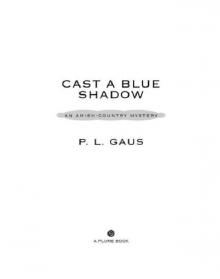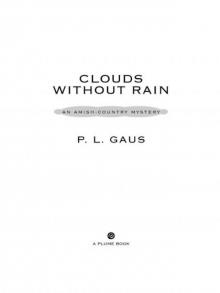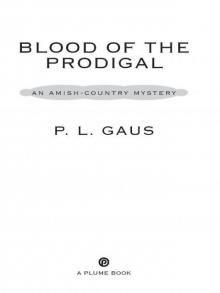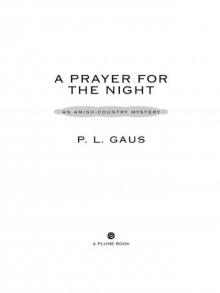- Home
- P. L. Gaus
Clouds without Rain
Clouds without Rain Read online
Table of Contents
A PLUME BOOK
Title Page
Copyright Page
Dedication
PREFACE AND ACKNOWLEDGMENTS
Chapter 1
Chapter 2
Chapter 3
Chapter 4
Chapter 5
Chapter 6
Chapter 7
Chapter 8
Chapter 9
Chapter 10
Chapter 11
Chapter 12
Chapter 13
Chapter 14
Chapter 15
Chapter 16
Chapter 17
Chapter 18
Chapter 19
Chapter 20
Chapter 21
Chapter 22
Chapter 23
Chapter 24
Chapter 25
Chapter 26
Chapter 27
Chapter 28
Chapter 29
Chapter 30
Chapter 31
Chapter 32
Teaser chapter
A PLUME BOOK
CLOUDS WITHOUT RAIN
PAUL LOUIS GAUS lives with his wife, Madonna, in Wooster, Ohio, just a few miles north of Holmes County, where the world’s largest and most varied settlement of Amish and Mennonite people is found. His knowledge of the culture of the “Plain People” stems from more than thirty years of extensive exploration of the narrow blacktop roads and lesser gravel lanes of this pastoral community, which includes several dozen sects of Anabaptists living closely among the so-called English or Yankee non-Amish people of the county. Paul lectures widely about the Amish people he has met and about the lifestyles, culture, and religion of this remarkable community of Christian pacifists. He can be found online at: www.plgaus.com. He also maintains a Web presence with Mystery Writers of America: www.mysterywriters.org.
PLUME
Published by the Penguin Group
Penguin Group (USA) Inc., 375 Hudson Street, New York, New York 10014, U.S.A. • Penguin Group (Canada), 90 Eglinton Avenue East, Suite 700, Toronto, Ontario, Canada M4P 2Y3 (a division of Pearson Penguin Canada Inc.) • Penguin Books Ltd., 80 Strand, London WC2R 0RL, England • Penguin Ireland, 25 St. Stephen’s Green, Dublin 2, Ireland (a division of Penguin Books Ltd.) • Penguin Group (Australia), 250 Camberwell Road, Camberwell, Victoria 3124, Australia (a division of Pearson Australia Group Pty. Ltd.) • Penguin Books India Pvt. Ltd., 11 Community Centre, Panchsheel Park, New Delhi - 110 017, India • Penguin Group (NZ), 67 Apollo Drive, Rosedale, North Shore 0632, New Zealand (a division of Pearson New Zealand Ltd.) • Penguin Books (South Africa) (Pty.) Ltd., 24 Sturdee Avenue, Rosebank, Johannesburg 2196, South Africa
Penguin Books Ltd., Registered Offices: 80 Strand, London WC2R 0RL, England
Published by Plume, a member of Penguin Group (USA) Inc.
First Plume Printing, December 2010
Copyright © P. L. Gaus, 2001
Excerpt from Cast a Blue Shadow copyright © P. L. Gaus, 2003
All rights reserved
REGISTERED TRADEMARK—MARCA REGISTRADA
The Library of Congress has catalogued the Ohio University Press edition as follows:
Gaus, Paul L.
Clouds without rain : an Ohio Amish mystery / P. L. Gaus.
p. cm.
eISBN : 978-1-101-47798-4
Without limiting the rights under copyright reserved above, no part of this publication may be reproduced, stored in or introduced into a retrieval system, or transmitted, in any form, or by any means (electronic, mechanical, photocopying, recording, or otherwise), without the prior written permission of both the copyright owner and the above publisher of this book.
PUBLISHER’S NOTE
This is a work of fiction. Names, characters, places, and incidents are either the product of the author’s imagination or are used fictitiously, and any resemblance to actual persons, living or dead, business establishments, events, or locales is entirely coincidental.
The scanning, uploading, and distribution of this book via the Internet or via any other means without the permission of the publisher is illegal and punishable by law. Please purchase only authorized electronic editions, and do not participate in or encourage electronic piracy of copyrighted materials. Your support of the author’s rights is appreciated.
BOOKS ARE AVAILABLE AT QUANTITY DISCOUNTS WHEN USED TO PROMOTE PRODUCTS OR SERVICES. FOR INFORMATION PLEASE WRITE TO PREMIUM MARKETING DIVISION, PENGUIN GROUP (USA) INC., 375 HUDSON STREET, NEW YORK, NEW YORK 10014.
http://us.penguingroup.com
Because of my wife, Madonna, and dedicated to our daughters, Laura and Amy
Jude 12
These men are blemishes at your love feasts, eating with you without the slightest qualm—shepherds who feed only themselves. They are clouds without rain, blown along by the wind; autumn trees, without fruit and uprooted—twice dead.
Thursday, July 6, 2000
Associated Press
For the first time in at least 20 years, the average price of farmland in Ohio exceeds that of all the other Corn Belt states. The steady development of houses and shopping centers in rural Ohio eventually pushed the state into the top spot, an agricultural expert said yesterday. “In the past, farmland was owned by farmers for agricultural purposes,” said Allan Lines, an agricultural economist at Ohio State University. “What we’re seeing now is we have all these other interests there in owning a piece of the real estate.”
PREFACE AND ACKNOWLEDGMENTS
Not all of the places in this story are real, but all are as authentic to Holmes County, Ohio, as I know how to make them. Any resemblance to persons living or dead is purely coincidental, and any reference to legal and trust practices is my own fabrication, as are the events in this story. I have moved and altered the description of the psychiatric ward at Aultman Hospital. The ritual barn was located in Panther Hollow, not Walnut Creek Township. It has been destroyed.
Thanks go to the excellent staff at the burn unit in the Children’s Hospital Medical Center in Akron, Ohio, especially Julianne Klein, RN, BSN, and Mary Mondozzi, RN, MSN, as well as to Mark A. Harper of the Akron Fire Department, Ed Gasbarre of R. W. Gasbarre and Associates, Inc., surveyors, and Dr. Wayne M. Weaver of the Joel Pomerene Memorial Hospital in Millersburg.
Many thanks to Amish and former-Amish friends who do not wish to be named, and also to Chief Steve Thornton, Tom Kimmins, Esq., Ray and Kaye Fonte, Pastor Dean Troyer, and Eli Troyer—good friends, able advisors.
1
Monday, August 7
4:15 P.M.
PROFESSOR Michael Branden, driving a black Amish buggy, worked his horse at a walk along Walnut Creek Township Lane T-414, just north of Indian Trail Creek in Holmes County, Ohio, on a sweltering Monday afternoon early in August. Coming up to one of the short stretches of blacktop laid in front of a house to cut the dust, he slowed the horse and rolled gently onto the pavement. The buggy rocked and swayed from side to side on its light oval springs, and the iron wheels cut sharp lines through the tar blisters in the blacktop. The horse’s hooves gave hollow plopping sounds that switched back to a lighter clicking in the dust and gravel after the blacktop played out beyond the house. The sky was cloudless, the sun hot, and beyond the thin line of trees that bordered the lane, the fields seemed withered and spent, the crops stricken with thirst.
Branden was dressed to outward appearance as an Amish-man. The Amish clothes and broad-brimmed straw hat with a flat crown were his own, bought two summers before, when he had worked on a kidnapping case involving an Amish child. He was wearing shiny blue denim trousers over leather work boots, a dark blue shirt with the sleeves rolled up to his elbows, and a black cloth vest, unfastened in front.
The professor brought the rig to a stop, took off his straw hat, poured a little water from a plastic bottle over his wavy brown hair, and rubbed at it vigorously. Then he laid his hat on the seat, and while he dried his tanned face and neck with a red bandanna, he straightened the rest of the gear riding beside him.
There was a black radio handset from the sheriff’s department, turned off for the task at hand. A Holmes County map from the county engineer’s office, folded to the square of Walnut Creek Township. An elaborate Contax RTS III SLR camera with a long Zeiss lens, tucked securely into the corner of the buggy seat. On the floorboards under the seat, a Smith and Wesson Model 60 .357 Magnum revolver in a black leather holster.
With a light slap of the reins, Branden started the horse again. About a hundred yards further up the lane, he pulled into the drive of a new two-story Amish house and stepped the horse to a stone watering trough. A door on the upper floor opened as he stopped. Lydia Shetler, dressed in a plain, dark-blue dress and black bonnet, came out onto the top porch of the house and asked, “Any luck, already?” with the classic Dutch accent of the region.
The professor shook his head and said, “Mind if I water the horse?”
Lydia intoned, “If it suits you,” and leaned over with her elbows on the porch rail to watch.
The porch, braced with tall posts, was level with the second floor of the house. The area under this high porch was latticed in front with a rose arbor, which made a shady breezeway at ground level. The family’s laundry was hung out for the day, drying on clotheslines in the breezeway.
Branden climbed out, and as the horse snorted and drank water, Lydia asked, “How much longer do you figure to make these rides, yet, Herr Professor?”
“Till we get them,” Branden said and laughed. He slapped his hat at the dust on his ankles and added, “Or until the sheriff gets bored with the idea.”
Lydia nodded as if to say that she understood the sheriff’s impulsiveness well enough, and asked, “Are you sure only our two families know about your business?”
“Why? Have you heard anything on the gossip mill?”
“Not a word.”
“Then I suppose I’ll still keep riding. As long as nobody at either end lets it slip.”
“I haven’t heard any mention,” Lydia repeated, and went back inside. Branden mounted into the buggy, swung around on the wide gravel lane, and walked his horse out to T-414 again, continuing east toward the little burg of Trail.
This was his fifth afternoon drive in two weeks, traveling the northern edges of Walnut Creek Township on the center-east edge of Holmes County. His assignment was to be the decoy in Sheriff Bruce Robertson’s strategy to catch the two Amish-clad teenagers who were making a reputation for themselves that summer by robbing the Peaceful Ones. Disguised in rubber goat’s-head masks, they rode up to the slow-moving buggies on their mountain bikes and demanded money. Surprisingly large sums had been involved, and Sheriff Robertson now had his decoy in place. Professor Michael Branden, Civil War History, Millersburg College, a duly sworn reserve deputy, with a buggy, a costume of Amish clothes, a radio, an ample supply of handcuffs, and a very expensive camera. Also a revolver, just in case.
As the professor rattled along slowly in his buggy, a pickup shot by in the opposing lane. In the cloud of dust left in its wake, two Amish teenagers passed from behind on mountain bikes. Branden took up his camera and fired off several frames on motor drive.
Branden tensed a bit, wondering what he would actually do if the young bandits ever did approach him demanding money. He wasn’t at all certain that the sheriff was right about this one. Amish or English, they wouldn’t be that easy to apprehend. “They’re Amish, Mike,” Robertson had said. “They’ll just stand there when you show them your badge.” And if he took their picture or stepped down from the buggy to confront them? What then? They’d take off on their bikes.
That’d be it, Branden thought dourly. They’d scatter, and he wouldn’t have a chance of chasing them down in the heat. The professor shook his head, laughed halfheartedly, and wondered about the ribbing he’d take from the regular deputies if the sheriff’s little game should play out as he suspected it might, with him giving chase through fields or over hills, losing them both.
Chagrined, Branden rode the rest of his shift haphazardly back and forth along narrow T-414, radio off so as not to give him away. As the supper hour approached, he headed south on T-412 to return the buggy to its owner. As he brought the buggy into the Hershbergers’ drive, one of the middle sons, Ben, stepped out of a woodshop at the side of the property, slapping sawdust off his long denim apron. He waved to Branden and came down the steps to a hitching rail beside the gravel drive. The drive curved gently around a well-tended volleyball court and dropped with the slope of the land into a wide valley, passing the north side of a weathered white house. Three stories and gabled, the historic building had a round sitting room and cone-shaped roof set at the corner, where a large covered porch began at the front and wrapped around the side. Grandmother Hershberger sat peacefully in an oak rocker on the elevated porch, a small mound of potatoes on the floor at her side, peeling long, curling skins into her lap. Branden tipped his hat, and she glanced briefly at him with reserved acknowledgment. As Ben came forward and took the horse by the bridle, Branden turned on his handset radio and heard Sheriff Bruce Robertson shouting, “Two ambulances. Maybe three! Ellie, send five!”
“Fire’s on their way, Sheriff,” Ellie Troyer said, her voice frayed with tension.
“It’s a mess, Ellie,” Robertson’s voice cracked staccato over the radio. “One buggy, maybe more. Can’t tell yet. A semi jackknifed. Cab upside down in the ditch. The trailer has taken out at least one car and it’s burning now,” followed by, “For crying out loud, Ellie, where are my squads?”
“On their way,” Ellie said, managing to sound calm.
“Schrauzer’s unit is up there right in the middle of the whole thing,” Robertson shouted into the microphone. “Can’t see him anywhere. Going closer, Ellie. Get those fire trucks down here NOW!”
The mic clicked off for a bit and then Robertson called in again, more subdued. “Get the coroner, too, Ellie.”
Branden pulled his buggy up sharply, set the hand brake, scrambled down onto the driveway, and took the radio off the buggy seat. He paced in a circle on the drive as he made his call. “This is Mike Branden. Over.”
Ellie’s voice came back. “Signal 39.”
“Township 412 at the Hershbergers.” As he spoke, he gathered his things from the buggy and walked quickly to his small pickup.
“It’s right there, Professor,” Ellie said. “You’re practically on top of it. 515 south of Trail.”
“Roger that,” Branden said and started his engine. “515 south of Trail. Ellie, I’ll be right there!”
He pulled the door closed, fish-tailed on the gravel lane, waved at Ben, and heard Robertson come over the radio.
“Mike, you come in from the north. South of Trail. That’ll put you on the other side. I’m farther south, the other side of the pileup, and I need someone on your side to stop traffic.”
“I’m coming up on Trail now,” Branden said, steering with his left hand, holding the handset with the right.
“Turn right at Trail, Mike,” Robertson said. “Slow. We’re down in a little valley and if you don’t come in slow, you’ll run us all over.”
Branden dropped south out of Trail on 515, came around a sharp curve and over a hill, and saw a tall plume of black smoke beyond the next rise in the road. He came up to the top of the hill, stopped abruptly, stepped out of the truck, and leaned forward on the open door, shaken by w
hat he saw some hundred yards below.
A semitrailer rig sprawled across the road, the cab overturned in the right-hand ditch, the trailer laid across the road on its side, its rear wheels spinning slowly over the left-hand ditch. The truck driver lay twisted on the pavement beside the overturned cab.
A monstrous gasoline fire engulfed a sedan pinned under the far side of the trailer, and dense smoke drifted up and trailed west over a field of stunted corn. The flames leaped from the road to the grasses in the roadside ditches and spread rapidly into the withered crops in the fields on each side of the road. Even at this distance from the wreckage, Branden could smell the smoke and the gasoline. He heard a car approaching behind him and turned to stop it with a palm held outward. A second car pulled up, and then a third. He took up a position to block the passing lane and turned back to view the wreckage.
Just beyond the burning sedan was Phil Schrauzer’s cruiser. Something long and bulky had punched through the windshield. Further back there was a line of two pickups and a produce truck, all apparently uninvolved in the wreck. Two of the three drivers stood helplessly beside their trucks. The third had stooped to open a briefcase on the pavement. As Branden watched, the man took a cell phone out of the briefcase, stood sweating profusely while he dialed a number, and talked as he turned his head this way and that, looking with astonishment at the wreckage that lay around him. The man fixed his gaze on the house at the end of the driveway, spoke for a moment longer, switched off the cell phone, and dialed another call. He spoke for perhaps a minute, listened briefly, and tossed the phone into the briefcase on the pavement. Kneeling down, he closed the case, and stood to drop it through the open window onto the front seat of his pickup.

 Stars for Lydia
Stars for Lydia Cast a Blue Shadow
Cast a Blue Shadow Separate from the World
Separate from the World Clouds without Rain
Clouds without Rain Blood of the Prodigal
Blood of the Prodigal Whiskers of the Lion
Whiskers of the Lion A Prayer for the Night
A Prayer for the Night Broken English
Broken English Harmless as Doves: An Amish-Country Mystery
Harmless as Doves: An Amish-Country Mystery